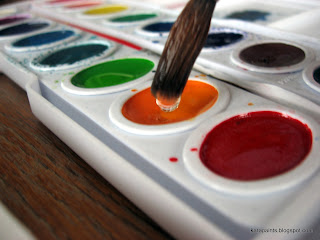Welcome! I hope you're ready to get back into working with watercolors--I know I have missed it!
This time we'll be exploring 6 techniques and talking about working with the wet in wet method.
Working wet in wet can yield some really beautiful results, but it's also a little unpredictable. It's best to go into it knowing that you can guide your color, but you can't tame it. If you are super OCD this is probably not the technique for you. Here are some tips to help you manage this crazy colorful technique:
1. Paint won't flow where the page is dry. If you want to create shapes or work around shapes, you can lay down a wash of plain water on your page to direct the flow of the paint.
2. Watercolors can be "erased". Not with an eraser, but with plain water and a paper towel. Lay down your water and DAB up the puddle. Don't rub--rubbing will move around the fibers on your paper and leave a weird-looking spot.
3. Use watercolor paper. Sketch paper, drawing paper,and Bristol board are not designed to hold the weight/moisture of the water. Watercolor paper is somewhat like painting on a sponge. You'll be a lot happier with your end result when you use the right paper--it won't curl, rumple, or disintegrate (unless you use WAY too much water)
4. Play first. It's a good idea to play around with techniques and color combinations before you attempt a masterpiece.For play, it's okay to use heavier-weight sketch paper (80 lb and up)
5. Let it dry between layers. This way you'll experience minimal color mixing, and you won't wind up with a muddy painting of muddy colors.
6. Mistakes happen. It's okay to start over, it's okay to walk away. I've been painting with watercolors for 17 years--and I have started over and walked away many MANY times.
Ready to get started?
Assemble your supplies!

Paint
Paintbrushes (a 3/4" flat and an 8 round--or thereabouts)
Paper
Water x2 (one for fresh and one to rise out your brush)
Sponges (one natural and one synthetic)
Salt
Paper towel
Terrycloth towel
Since we're going to be working with wet-in-wet, you need to dampen your paints. The easiest way to do this is to dip your round brush into the clean water and then drop the excess into the paint well. Wait until you see the bead of water hanging off the edge of the brush, and then just place the water drop on the paint. You don't need to put the brush into your color--gravity will pull the water off the brush.

A brief word about brushes: flat brushes hold less water (and therefore less color) than round brushes.
Round brushes are commonly called "mops" in the watercolor vernacular, because of the water they hold and the way you use them to push the paint around.
Now on to techniques!
Mixing two colors on a wet page
Lay down clean water with your flat brush.
With your round brush, paint over the left side with purple.
While this is still wet, lay down teal on the right side.
When everything is still wet, you can push the paint around a little bit.
Things are going to puddle and run together a bit.
As it dries, the paint will spread out to cover the wet surface and create hard edges of color.
Color over color on a dry page
Lay down a wash of yellow with your flat brush, and lay down a wash of red over the still-wet yellow. Don't mix them together--let the water act as your mix. It yields interesting results--the end results remind me of salt deposits on flood plains.
Add salt
Lay down a wash of teal and a wash of dark green. To get it soupy-looking, use your round brush.Sprinkle with kosher salt and let dry. Once completely dry, brush off the salt.
The results will vary based on how wet your paint is, how much salt you use, and the humidity levels.
Splatter
Lay down a wash of yellow (flat or round brush). Splatter magenta into the wet paint using your round brush--really load it up with paint. And if you need to flick it more than once, go for it.
Blotting
This can be done with a variety of absorbent materials: paper towels, sponges, terry cloth towels, old t-shirts or socks, tissues, newspaper.
Here, I've laid down a wash of lime green on dry paper with dark green over it. Then I blotted with a natural sponge.
I recommend you try it with paper towels also--often the pattern in the towel gets left in the top layer of paint.
This leaves a really subtle end result--just the faintest hint of texture. I used my round brush for this one.
Painting with sponges
Lay down a wash of orange with your flat brush on dry paper, then get your sponge wet. (dip it in the clean water and squeeze out the excess) Dab the damp sponge into the magenta paint and apply to the wet orange.
I love the way part of the orange was lifted off by the damp sponge, and the feathery texture as the two colors bled into one another.
That's it for this week. Try all these techniques on dry paper and on wet paper. You'll be surprised at the variety you can achieve, and you'll be sure to find a favorite.
Next week we'll do a few more wet in wet techniques and get started on a painting.














































